- Table of Content
- 1.Counting down ...
- 2.ESWW2018 - Des...
- 3.Review of sola...
- 4.PROBA2 Observa...
- 5.The Internatio...
- 6.Review of geom...
- 7.Geomagnetic Ob...
- 8.Review of iono...
2. ESWW2018 - Design 4 Ticket
3. Review of solar activity
4. PROBA2 Observations (10 Sep 2018 - 16 Sep 2018)
5. The International Sunspot Number
6. Review of geomagnetic activity
7. Geomagnetic Observations at Dourbes (10 Sep 2018 - 16 Sep 2018)
8. Review of ionospheric activity (10 Sep 2018 - 16 Sep 2018)
Counting down to the Open Doors
On Saturday 29 and Sunday 30 September 2018, the Space Pole (the Royal Observatory of Belgium, the Royal Meteorological Institute and the Royal Belgian Institute for Space Aeronomy) will open its doors to the public.
The program includes activities for young and old. You can visit the telescopes, the climate center or the virtual weather office. Or you can follow one of the many thematic lectures. The creation of aurora in a dark room will surely amaze you, and you can learn everything you ever wanted to know on the study of the Earth, planets, moons and comets from our own solar system to far beyond in the universe. Our scientists will be happy to discuss with you at the various information stands and will also animate workshops and live scientific experiments. There are also plenty of activities for children. A picnic area and foodtrucks will be available on site.
The STCE will organize and participate in numerous activities. The solar dome and the solar telescopes will be accessible which allows -weather permitting- to observe the Sun. Space weather forecasters will explain how they (try to) predict the conditions on the Sun and in space, and the PROBA2 Science Centre will have a full-scale model of the PROBA2 solar satellite. A visit of the SSCC, the first European Space Weather Helpdesk, as well as of the Planeterrella, an impressive auroral simulator, is highly recommended. In the experiments tent, scientists will reveal the mysteries behind spectroscopy and how they use this tool in their research. You can also get acquainted with how to draw and classify sunspots.
The full program can be found at the Open Doors 2018 website:
- in Dutch: http://spacepole.be/index.php/nl/opendeurdagen-2018
- in French: http://spacepole.be/index.php/fr/journees-portes-ouvertes-2018
At most of the stands, explanations can also be given in English.
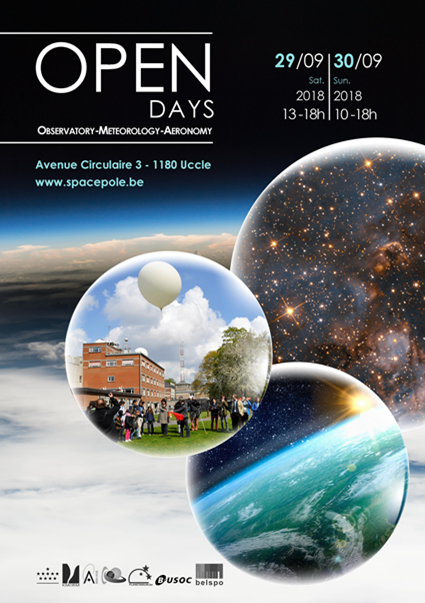
ESWW2018 - Design 4 Ticket
The Programme Committee of the European Space Weather Week organises a theme picture contest. This year was the second edition.
The five member jury deliberated all the submissions received and came to a conclusion.
They are happy to announce the winner of the 'a Design 4 Ticket' contest: Erika Palmerio with
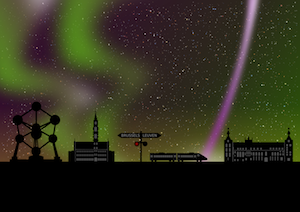
The design of Erika will be used for the website banner, the esww15 poster, the esww15 badges, presentations, ... and Erika wins a full week esww15 ticket!
It was a neck and neck race with Lilla Juhasz:

Check all details: http://www.stce.be/esww15/postercontest.php
Review of solar activity
Solar activity was at low level.
Two inactive sunspot group were observed: NOAA 2721 and NOAA 2722.
No coronal mass ejections (CMEs) were observed.
The greater than 10 MeV proton flux was at nominal levels.
A trans-equatorial negative coronal hole (CH) transited the central meridian on 13-14 September.
Below a solar synoptic map or drawing made by SWPC (https://www.swpc.noaa.gov/products/solar-synoptic-map) compared with a real EUV picture of the Sun on the same day. The red line in the EUV picture is drawn offhand.
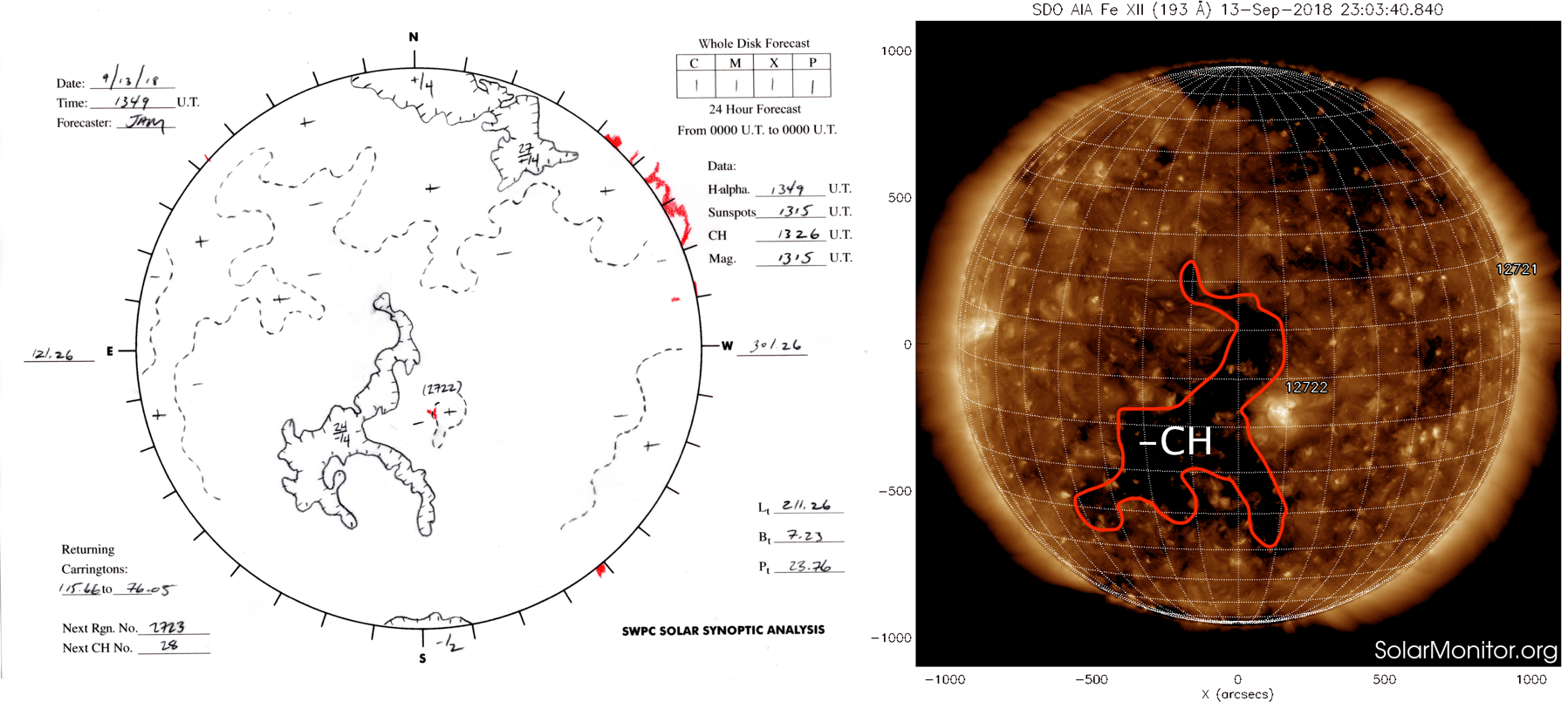
PROBA2 Observations (10 Sep 2018 - 16 Sep 2018)
Solar Activity
Solar flare activity remained very low during the week.
In order to view the activity of this week in more detail, we suggest to go to the following website from which all the daily (normal and difference) movies can be accessed: http://proba2.oma.be/ssa
This page also lists the recorded flaring events.
A weekly overview movie can be found here (SWAP week 442): http://proba2.oma.be/swap/data/mpg/movies/weekly_movies/weekly_movie_2018_09_10.mp4
Details about some of this week’s events, can be found further below.
If any of the linked movies are unavailable they can be found in the P2SC movie repository here: http://proba2.oma.be/swap/data/mpg/movies/
Tuesday Sep 11
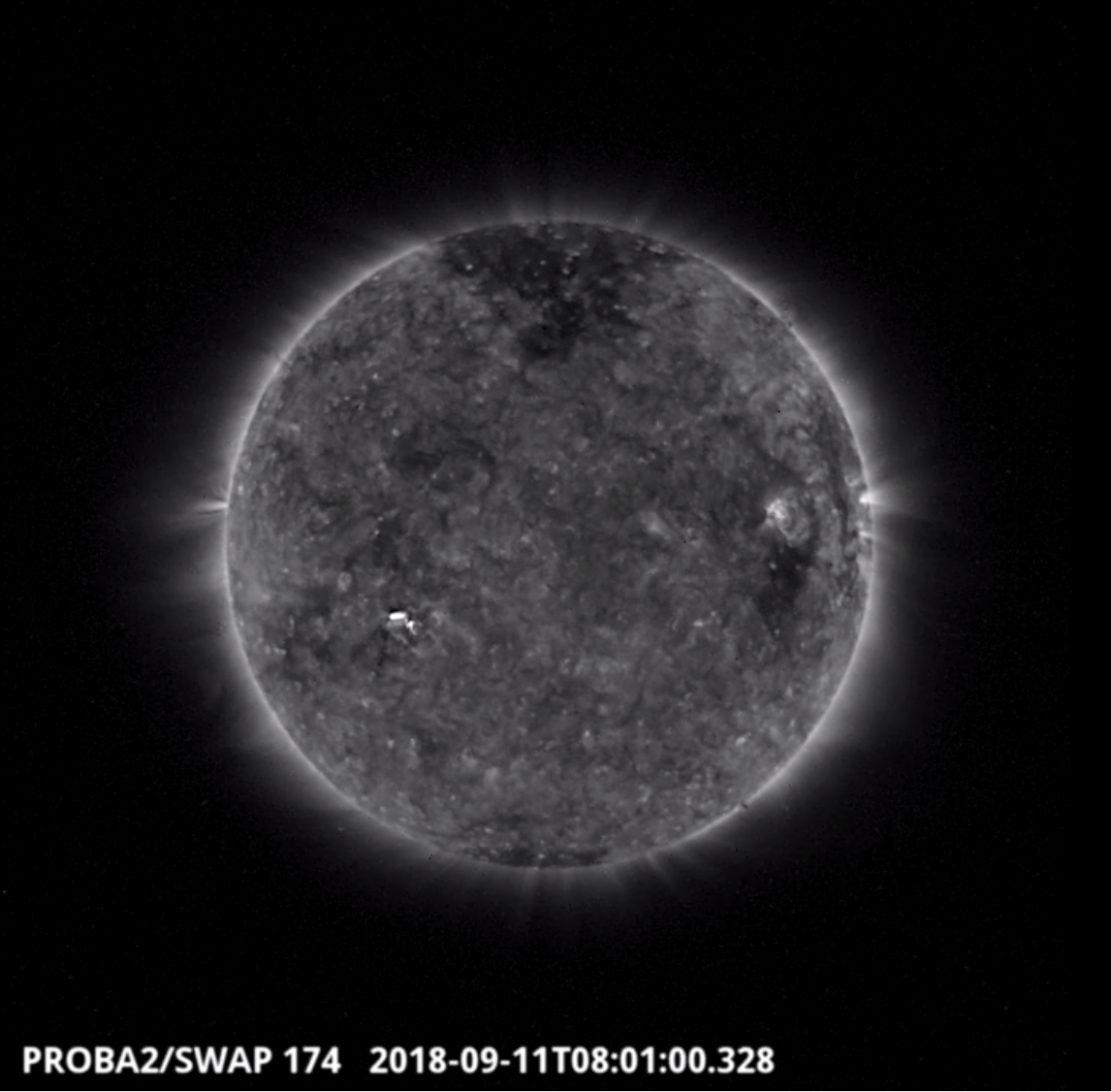
The largest flare of the week (B1.0) was observed by SWAP on 2018-Sep-11. The flare is visible in the south-east quadrant of the solar disk in the SWAP image above at 08:01 UT.
Find a movie of the event here (SWAP movie): http://proba2.oma.be/swap/data/mpg/movies/20180911_swap_movie.mp4
The International Sunspot Number
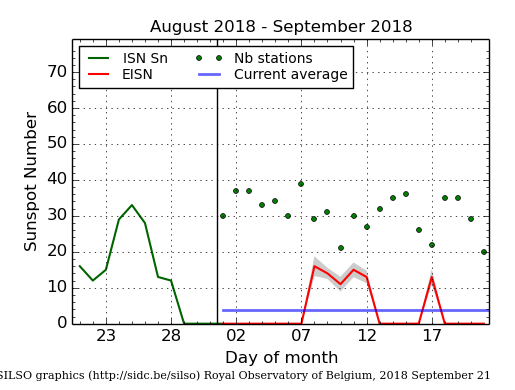
The daily Estimated International Sunspot Number (EISN, red curve with shaded error) derived by a simplified method from real-time data from the worldwide SILSO network. It extends the official Sunspot Number from the full processing of the preceding month (green line). The plot shows the last 30 days (about one solar rotation). The horizontal blue line shows the current monthly average, while the green dots give the number of stations included in the calculation of the EISN for each day.
Review of geomagnetic activity
Solar wind conditions started the week under the influence of a positive polarity coronal hole high speed stream (HSS). The coronal hole transited the central meridian on 7-8-Sep-2018. Below a synoptic map by SWPC drawn on Sep 7 2018.

The solar wind speed reached a maximum of 620 km/s on 11-Sep-2018 and 650 km/s on 15-Sep-2018. From that point in time, the speed declined.
The total magnetic field strength has fluctuated around 5 nT. The Bz component has fluctuated between -5 and +5 nT.
Geomagnetic conditions ranged between Kp index 1-6 (NOAA) and local K index 0-5 (Dourbes) over the past week. The geomagnetic conditions reached storm levels on a planetary level on Tuesday (11-Sep-2018), due to a jump in the solar wind speed combined with a Southward orientation of the magnetic field, caused by the HSS from the positive polarity coronal hole that transited the central meridian on 8-Sep-2018.
Review of ionospheric activity (10 Sep 2018 - 16 Sep 2018)

The figure shows the time evolution of the Vertical Total Electron Content (VTEC) (in red) during the last week at three locations:
a) in the northern part of Europe(N61°, 5°E)
b) above Brussels(N50.5°, 4.5°E)
c) in the southern part of Europe(N36°, 5°E)
This figure also shows (in grey) the normal ionospheric behaviour expected based on the median VTEC from the 15 previous days.
The VTEC is expressed in TECu (with TECu=10^16 electrons per square meter) and is directly related to the signal propagation delay due to the ionosphere (in figure: delay on GPS L1 frequency).
The Sun's radiation ionizes the Earth's upper atmosphere, the ionosphere, located from about 60km to 1000km above the Earth's surface.The ionization process in the ionosphere produces ions and free electrons. These electrons perturb the propagation of the GNSS (Global Navigation Satellite System) signals by inducing a so-called ionospheric delay.
See http://stce.be/newsletter/GNSS_final.pdf for some more explanations ; for detailed information, see http://gnss.be/ionosphere_tutorial.php
